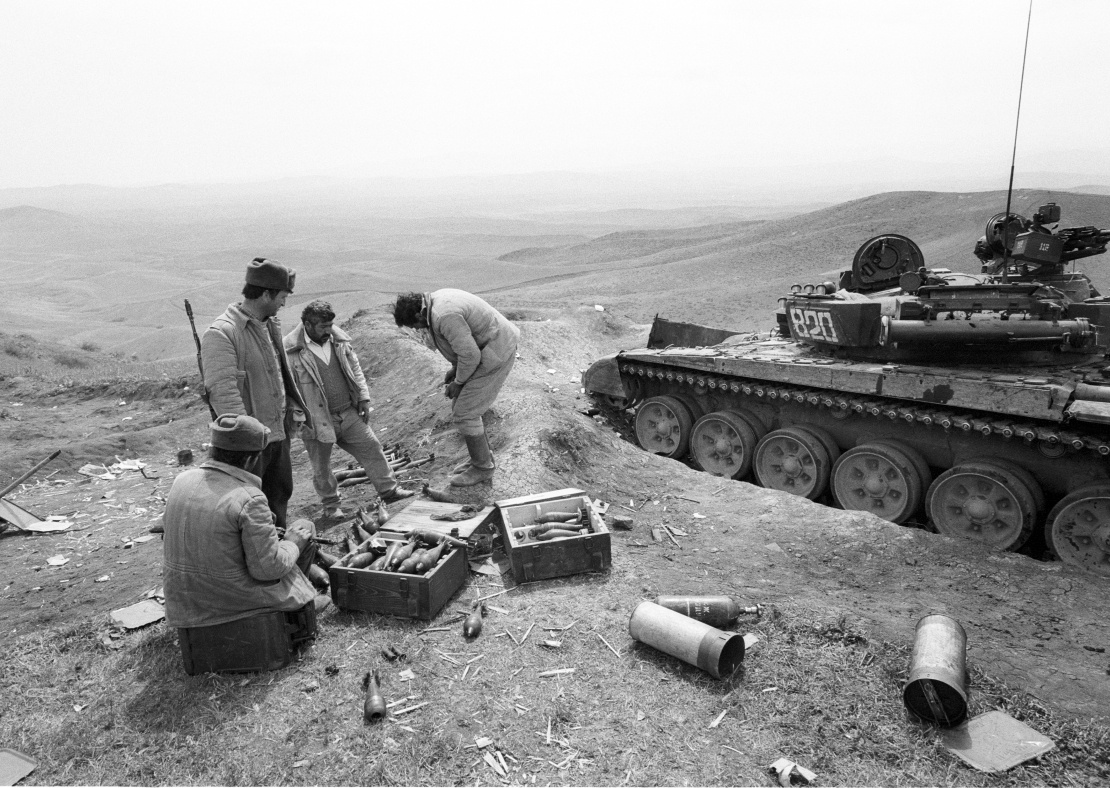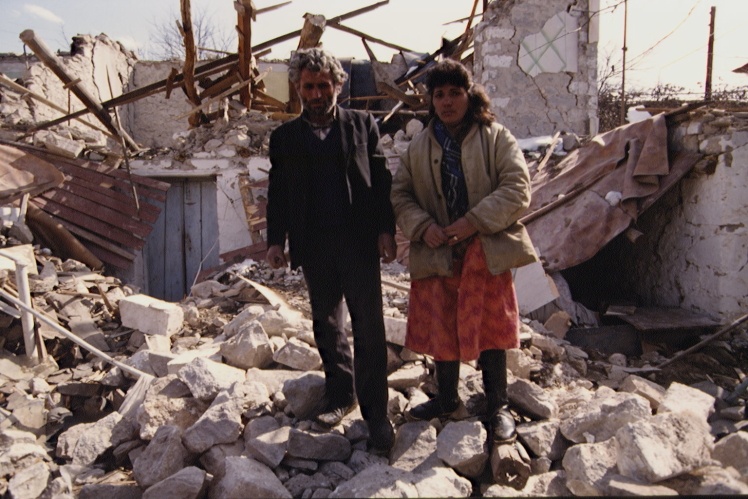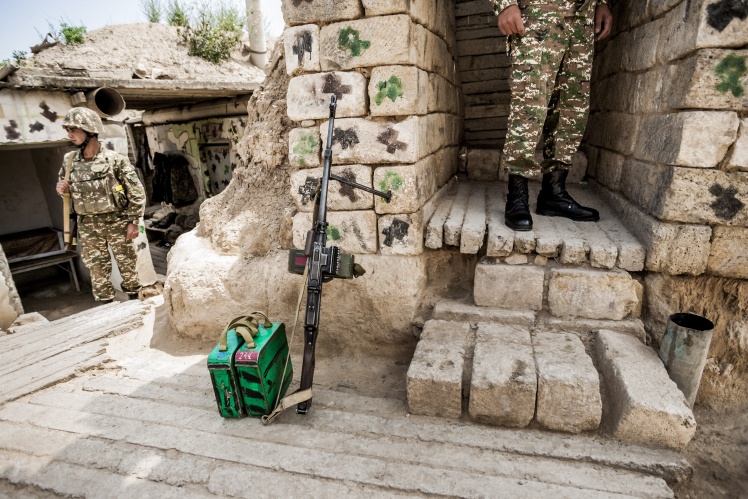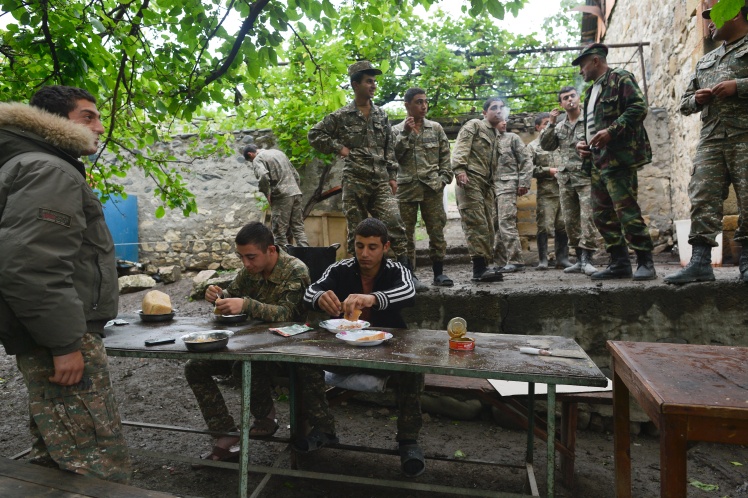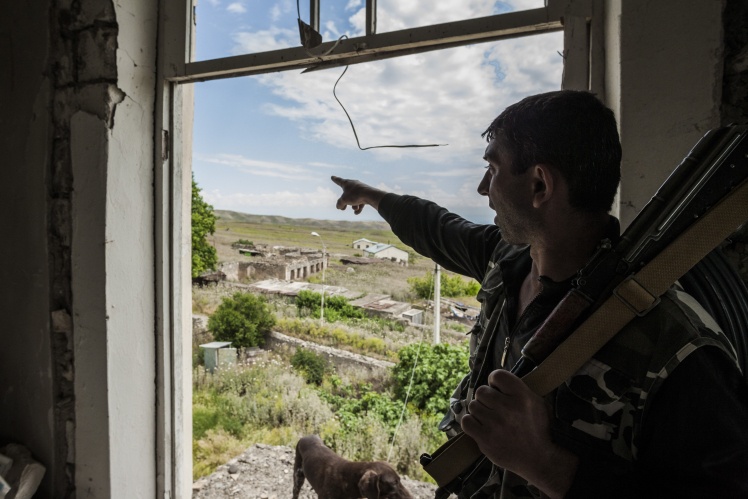Armenian soldiers during the lull in Nagorno-Karabakh, 1993.
Pre-Soviet period
Armenia version
Karabakh, or Artsakh, is historically the territory of Armenia. As a part of Armenia, it is mentioned since the 6th century BC in the works of ancient historians — Pliny the Elder, Plutarch and Claudius Ptolemy. After the collapse of the kingdom of Great Armenia in 387, Artsakh became part of the Eastern Armenian kingdom, and later came under the rule of Persia. In 1813, after the end of the Russo-Persian war, Karabakh ceded to Russia.
In 1917, the Russian Empire fell apart. At the same time, three republics began to form: Armenian, Azerbaijani and Georgian. Nagorno-Karabakh is a region of Greater Karabakh where Armenians lived compactly, convened the first congress, elected the government and the National Council, and declared itself independent. Since May 1918, Azerbaijan, with the support of Turkey, tried to seize Nagorno-Karabakh. In 1919, Karabakh and Azerbaijan concluded an agreement, according to which the status of the region was to be determined at the Paris Peace Conference.
Azerbaijan version
Karabakh is a historical region of Azerbaijan, which is mentioned in 1300-year-old sources. Its name comes from the Azerbaijani words "gara" — black and "bah" — garden. The name of a part of the district, Nagorno-Karabakh, appeared in the early 1800s, during the decline of the Karabakh Khanate. In Azerbaijan, Karabakh is not divided into mountainous and plain, for the country, the entire region is integral — Karabakh.
In May 1805, during the Russo-Persian War, the Karabakh Khanate and Russia signed the Kyurechkai Agreement. After it, Karabakh Khan Ibrahim renounced any vassalage of Persia and other states and recognized the authority of the Russian emperor and his heirs. The document confirmed that Ibrahimʼs khanate was Muslim-Azerbaijani, and therefore Karabakh was originally an Azerbaijani land.
The population census, which was conducted after the liquidation of the khanate, showed that "out of 20,095 families, 15,729 were Azerbaijanis." Later, from 1828 to 1830, 90,000 Armenians were resettled from the Ottoman Empire to Azerbaijan, including Karabakh, and another 40,000 from Iran.
In 1917, the Russian Empire disintegrated, and in 1918, the Republic of Northern Azerbaijan appeared, which claimed Karabakh as well. Armenia also put forward its claims to the region, after which clashes began. They lasted until 1920.
Armenian quarters of the city of Shusha destroyed by the Azerbaijani armed forces in March 1920.
Soviet period
Armenia version
In April 1920, the Bolsheviks created the Azerbaijan Soviet Socialist Republic, and in November 1920, Soviet power was partially strengthened in Armenia as well. In its statement, the Revolutionary Committee of Azerbaijan recognized Nagorno-Karabakh, Nakhichevan and Zangezur as part of Armenia. In June 1921, on the basis of this statement, the National Council of the Azerbaijan SSR issued a declaration according to which Nagorno-Karabakh was transferred to Armenia. Armenia also declared Nagorno-Karabakh as its inseparable part. The decree was published in the official organ of the Central Committee of the Azerbaijan Communist Party, the newspaper "Bakinsky Robotnik" on June 22, 1921.
Armenian workers welcome the advance of the 11th Red Army on the city of Yerevan.
On the Fourth of July, a congress of the Communist Party of Russia was held in Tbilisi, where it was confirmed that Karabakh is part of Armenia. But already on July 5, Joseph Stalin canceled this decision and included Karabakh as part of the Azerbaijan SSR. And in 1923, Moscow formed the Nagorno-Karabakh Autonomous Oblast as part of Azerbaijan. Thus, Nagorno-Karabakh became a part of the Azerbaijan SSR with the rights of autonomy and remained there until 1991.
Azerbaijan version
In 1920, the chairman of the Revolutionary Committee of Azerbaijan, Nariman Narimanov, sent a telegram of congratulations to the Revolutionary Committee of Armenia and made a solemn speech about the establishment of Soviet power in Armenia. The executive committees of the two countries discussed the possible transfer of some regions of Azerbaijan to Armenia. This referred to Zangezur and Nakhichevan districts. In November, at a meeting of the Central Committee of the Communist Party of Bolsheviks of Azerbaijan, the delegates decided that it was politically unprofitable to give away regions to Armenia. Despite this, Zangezur district was handed over to Armenia already on November 30, and Narimanov read the declaration on December 1. In it, Zangezur and Nakhichevan counties were called an integral part of Armenia, and the working peasantry of Nagorno-Karabakh was guaranteed the right to self-determination. The text was printed in Baku newspapers.
The next day, Sergo Ordzhonikidze sent a telegram to Vladimir Lenin and Joseph Stalin, in which it was said that "Azerbaijan declared Nakhichevan, Zangezur and Nagorno-Karabakh in favor of Armenia." The news was printed in the Pravda newspaper. It is not known whether Ordzhonikidze deliberately distorted the information or was simply mistaken by mentioning Nagorno-Karabakh, but after some time, the head of the Azerbaijani Revolutionary Committee Narimanov stated that he did not say anything about the transfer of Nagorno-Karabakh to Armenia.
Stalin and Ordzhonikidze.
In June 1921, three issues were brought to the meeting of the Caucasian Bureau of the Communist Party: Azerbaijan, Zangezur and nomads. A secret protocol was attached to the Zangezur issue with the words: "Indicate in the declaration of the Armenian government that Nagorno-Karabakh belongs to the country." Thus, the Bolshevik party actually encouraged Armenia to claim rights to Nagorno-Karabakh. Already on June 12, Armenia issued a decree: "On the basis of the decision of the Regional Committee of Azerbaijan and the agreements between the republics of Azerbaijan and Armenia, from now on Nagorno-Karabakh is part of the SSR of Armenia."
On June 28, the Azerbaijan Council of Peopleʼs Commissars and the head of the regional committee Narimanov rejected the declaration on the recognition of Nagorno-Karabakh as the territory of Armenia, and its representative was expelled from the region.
On July 4, at a meeting of the Caucasian Bureau with the participation of Stalin and Ordzhonikidze, the issue of Karabakh was discussed again. They decided how to act: leave all of Karabakh to Azerbaijan, and hold a referendum in Nagorno-Karabakh on joining Armenia, or give Nagorno-Karabakh to Armenia without a referendum, and the rest of Karabakh to Azerbaijan. One of the influential members of the bureau, the representative of Soviet Russia in the Caucasus region Sergei Kirov, voted to simply give Nagorno-Karabakh to Armenia. But on July 5, by Stalinʼs decision, the bureau left Nagorno-Karabakh to Azerbaijan without a referendum. Kirov managed to defend that Nagorno-Karabakh became part of Azerbaijan with the rights of autonomy. Two years later, on July 7, 1923, the Central Executive Committee of Azerbaijan formed the Nagorno-Karabakh Autonomous Region (NKAR).
The period of Nagorno-Karabakh autonomy
Armenia version
All the time that the NKAR existed, the leadership of Azerbaijan violated the rights of Armenians, persecuted them for political reasons and discriminated against them on the basis of nationality. Azerbaijan destroyed Armenian monuments, specifically slowed down the economic growth of the region, and interfered in the demographic process. If in 1923 Armenians made up 94.4% of the population of the district, before the beginning of the war in 1989 only 76.6% of the locals were Armenians.
Preparation for the elections to the Supreme Council of the Azerbaijan SSR, a rally in Stepanakert of the Nagorno-Karabakh Autonomous Region.
Azerbaijan version
The creation of NKAR led to the growth of Armenian separatism in the region. The decree of 1923 introduced the rule: to speak Armenian with speakers of the Armenian language in the region, and to speak Azerbaijani with speakers of the Azerbaijani language. It turned out that Azerbaijanis in NKAR were in the minority and were discriminated against on the basis of language. The Armenian population enjoyed privileges. Moscow, in order to gain the loyalty of the Armenians, granted them wider rights and opportunities than the Azerbaijanis. In the end, NKAR turned into a ticking time bomb that exploded in 1988.
The collapse of the USSR, the war in Karabakh
Armenia version
In 1988, the USSR was in a deep political crisis. The population of Nagorno-Karabakh demanded self-determination. At the meeting of the Council of Deputies of the NKAR on February 20, 1988, representatives of the Armenian community decided to send a request to the Supreme Councils of the republics for the separation of Nagorno-Karabakh from Azerbaijan and its accession to the Armenian SSR. In response, the Azerbaijani authorities organized ethnic cleansing of Armenians throughout the republic. Armenians began to be expelled from and killed in Baku, Sumgait and Kirovabad cities. In December 1989, the authorities of NKAR and Armenia signed a resolution according to which the district was part of Armenia.
Patrol on a rural road in Nagorno-Karabakh, 1989.
In response, the Azerbaijani army shelled the Karabakh border. Already in January 1990, the Supreme Council of the USSR declared a state of emergency in the region. From April to May 1991, Azerbaijan conducted Operation Ring in the region. Azerbaijani Riot police and the Ministry of Internal Affairs deported the entire population from 24 Armenian villages of Nagorno-Karabakh. The Soviet militia tried to disarm the participants in the conflict, but in August 1991, a putsch began in Moscow, which led to the collapse of the USSR.
In December of the same year, a referendum was held in Nagorno-Karabakh, where the majority of residents voted for the independence of the Nagorno-Karabakh Republic. After that, a full-scale war began in the region. Self-defense of Nagorno-Karabakh, supported by the Armenian army, resisted the Azerbaijani army for three years. In the war, more than 25 thousand people were killed on both sides, hundreds of thousands became refugees. In 1994, Armenia, Azerbaijan and Nagorno-Karabakh concluded a truce.
Nagorno-Karabakh, 1992.
Azerbaijan version
In 1988, the government of the Armenian SSR took advantage of the instability in the USSR and began to fuel separatism in the region. Persecutions and attacks on Azerbaijanis began throughout the republic — more than 250 thousand people were expelled from Armenia. In February 1988, Armenians near the city of Askeran opened fire on a peaceful demonstration of Azerbaijanis protesting against the possible independence of NKAR. As a result, two Azerbaijanis were killed. In response, actions against Armenians began. In December 1989, the Supreme Council of the Armenian SSR passed a decision on the "reunification" of the Armenian SSR and Nagorno-Karabakh. The Presidium of the Supreme Council of the USSR condemned this decision — it could not be adopted without the consent of Azerbaijan.
In August 1991, Azerbaijan became independent. Three months later the Supreme Council of the already independent republic liquidated the Nagorno-Karabakh Autonomous Region, created by the USSR in 1923.
Armenia started a war against Azerbaijan. In 1992, Armenia staged the Khojaly Genocide — the military killed hundreds of Azerbaijanis, including women and children, thousands went missing, and the city of Khojaly was destroyed. During the year, the Armenian army occupied eight districts around Nagorno-Karabakh: Lachin, Shushin, Kelbajar, Aghdam, Fizulin, Jebrail, Gubadlin, and Zangelan. In 1993, the UN Security Council adopted four resolutions demanding the withdrawal of Armenian troops from Azerbaijani territories. On May 12, 1994, Armenia and Azerbaijan signed a cease-fire agreement.
Until that time, Armenia occupied twenty percent of the Republic of Azerbaijan, 20,000 residents were killed, 50,000 were wounded, 4,000 were missing, and about 900 settlements were destroyed.
Conflicts in the 21st century
Despite the peace agreement, in the region of Nagorno-Karabakh between the armies of Armenia and Azerbaijan there have been periodic clashes. In 2014, the Azerbaijani military shot down an Armenian Mi-24 helicopter. The government of Nagorno-Karabakh claimed that the helicopter belonged to the republic, while the leadership of Azerbaijan claimed that it was an Armenian helicopter "conducting hostile maneuvers." After this incident, constant shelling resumed on the border with Nagorno-Karabakh. In 2016, the Ministry of Defense of Armenia announced the offensive of the Azerbaijani army on Nagorno-Karabakh — Azerbaijan used tanks and artillery. The fighting lasted for three days until Azerbaijan stopped the operation. Armenia announced the signing of the peace agreement. According to UN estimates, 33 people died and 200 were injured.
In September 2020, the conflict flared up with renewed vigor, with Armenia accusing the Azerbaijanis of the attack and promising a "proportionate response". Martial law and mobilization were declared in Armenia and Nagorno-Karabakh.
In turn, Azerbaijan announced that it launched a counteroffensive in response to Armenian shelling. Subsequently, the Azerbaijani authorities announced that "Nagorno-Karabakh is a historical part of Azerbaijan, the country is regaining its lands."
Azerbaijani positions during the fighting in Nagorno-Karabakh in the fall of 2020.
The battles lasted from September 27 to November 10, 2020. During this time, about seven thousand soldiers died on both sides. About a thousand civilians were also killed or wounded. The war ended with an armistice brokered by Russia, which sent its peacekeepers to the region. According to the agreements, Armenia gave Azerbaijan most of the territories it had controlled since the early 1990s. Karabakh lost areas occupied by the Azerbaijani army during the fighting. Further negotiations regarding the status of the remaining territories were fruitless, and the truce between Armenia and Azerbaijan in Nagorno-Karabakh was repeatedly violated.
Translated from Ukrainian by Anton Semyzhenko.
